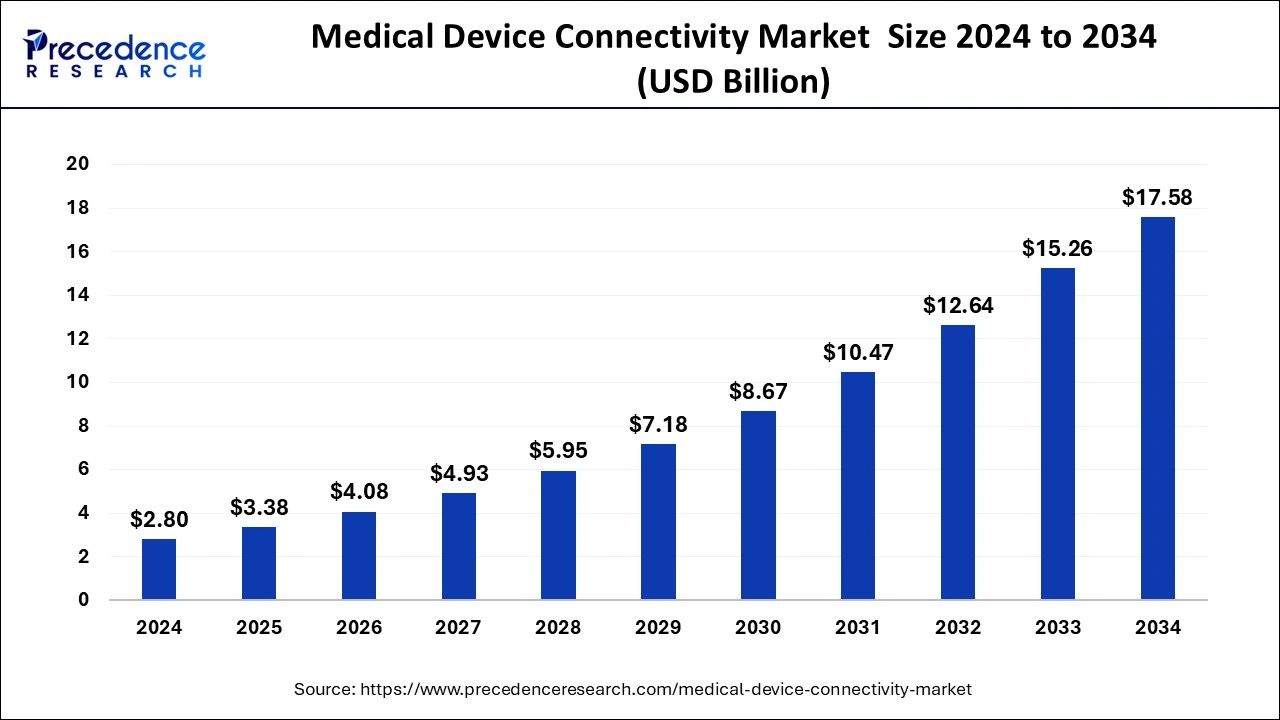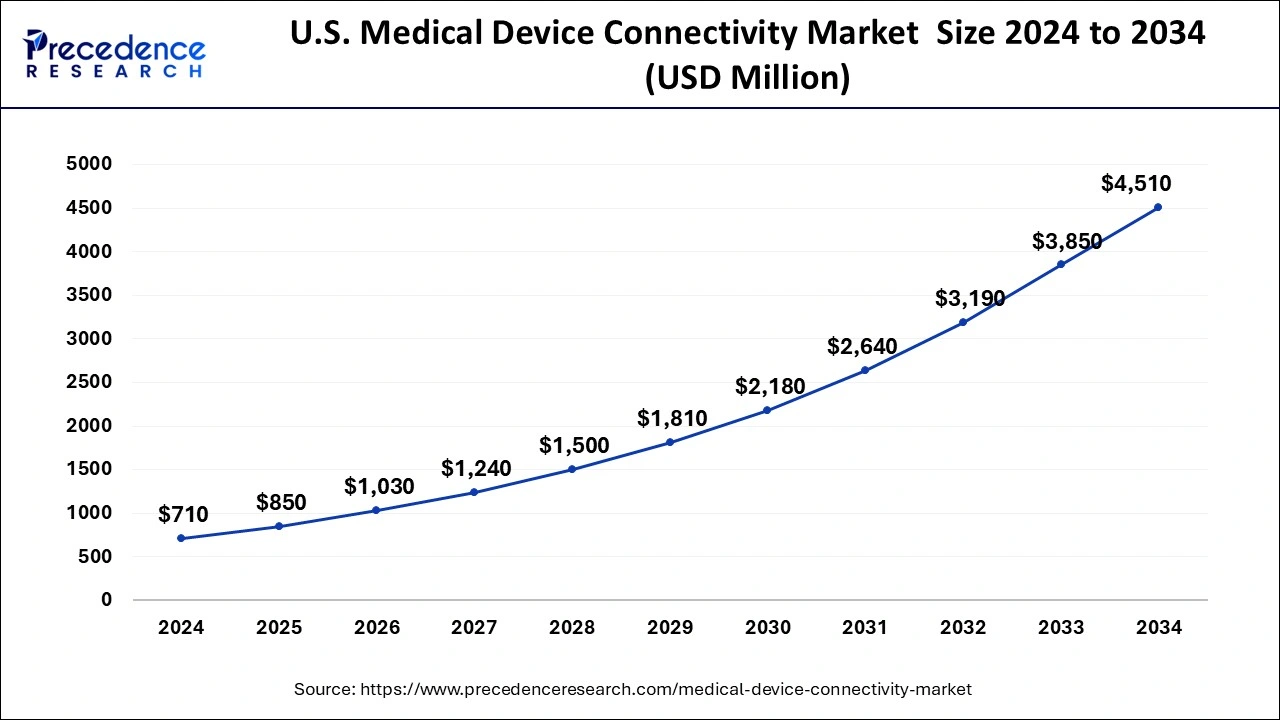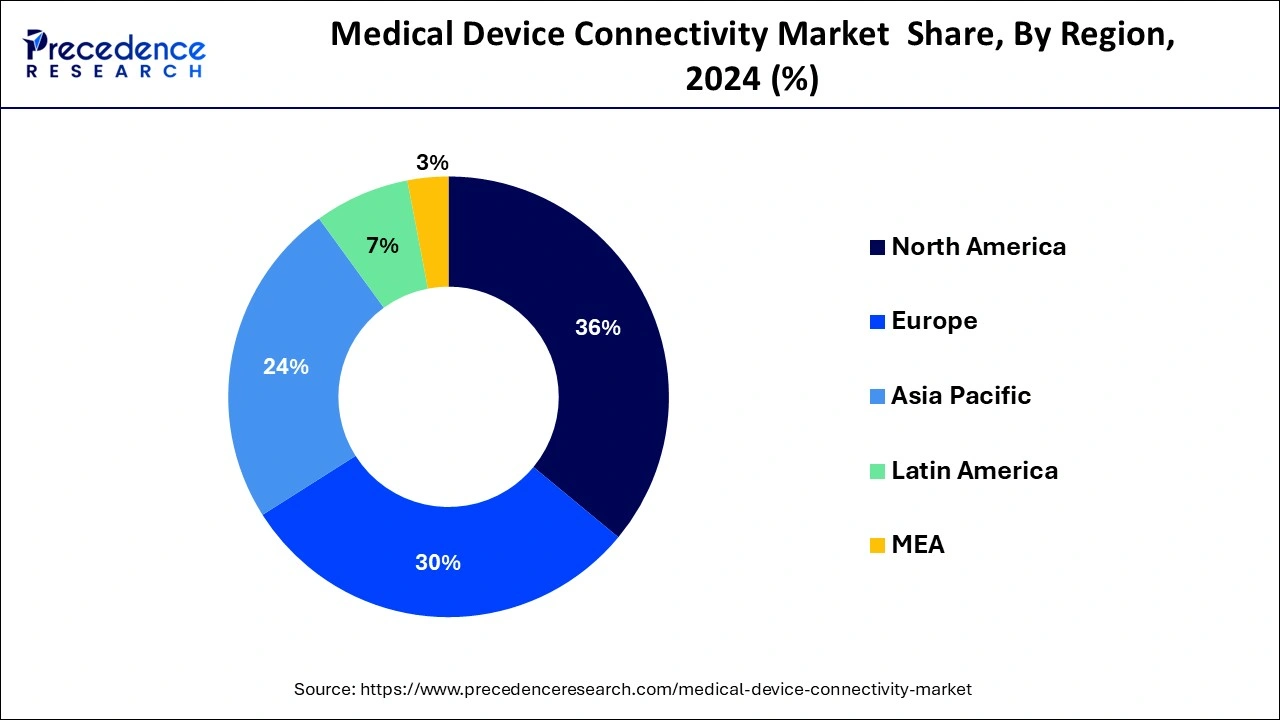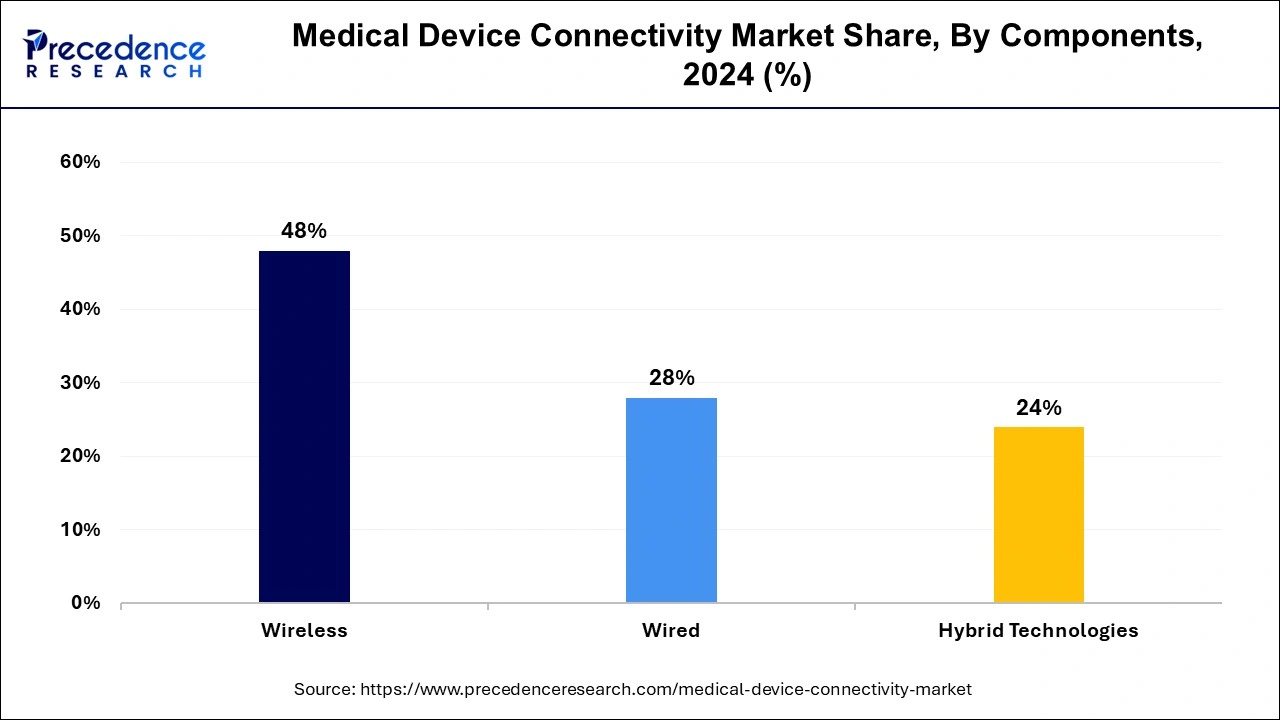January 2025
The global medical device connectivity market size is calculated at USD 3.38 billion in 2025 and is forecasted to reach around USD 17.58 billion by 2034, accelerating at a CAGR of 20.17% from 2025 to 2034. The North America medical device connectivity market size surpassed USD 1.01 billion in 2024 and is expanding at a CAGR of 20.21% during the forecast period. The market sizing and forecasts are revenue-based (USD Million/Billion), with 2024 as the base year.
The global medical device connectivity market size was estimated at USD 2.80 billion in 2024 and is predicted to increase from USD 3.38 billion in 2025 to approximately USD 17.58 billion by 2034, expanding at a CAGR of 20.17% from 2025 to 2034.

The U.S. medical device connectivity market size was estimated at USD 710 million in 2024 and is predicted to be worth around USD 4,510 million by 2034 at a CAGR of 20.31% from 2025 to 2034.

North America led the market with the biggest market share of 36% in 2024. This growth is driven by stringent regulatory standards and a strong emphasis on patient safety within the region. The implementation of robust medical device connection solutions, in compliance with regulatory requirements, is significantly contributing to the market's revenue growth trajectory in North America. As healthcare providers prioritize seamless integration and interoperability of medical devices to enhance patient care and streamline clinical workflows, the demand for advanced connectivity solutions is expected to continue rising, further fueling market expansion in the region.

Asia Pacific is estimated to expand at the fastest CAGR of 25.7% between 2025 to 2034. Rapid market expansion is fueled by escalating investments in research and development, aimed at fostering technologically advanced medical facilities. Favorable government initiatives and rising per capita income levels further propel market growth. China dominates the Asia-Pacific medical device connectivity market due to its large healthcare sector and technological advancements. Additionally, the Indian market is expected to exhibit steady growth, supported by increasing adoption of healthcare technologies and rising healthcare spending. Overall, these factors contribute to the rapid expansion of the medical device connectivity market in the Asia-Pacific region.
The medical device connectivity market in the Europe region has the second-highest market share. The market is witnessing significant growth in the region, driven by the widespread adoption of connection systems and services for medical equipment. Countries like Germany, with its advanced healthcare infrastructure, lead the market with substantial market share. Meanwhile, the UK is poised for substantial growth, spurred by increasing investments in healthcare technology.
The medical device connectivity market offers an integrated system of medical equipment designed to focus on patient care by continuously monitoring and analyzing electronic health records (EHR). Through wireless network technologies, various medical devices are interconnected, allowing healthcare providers to monitor patients' vital signs and health status remotely, even when they are not physically present. Hospitals prioritize access to comprehensive, precise, and detailed medical device data to improve clinical outcomes and enhance patient safety, especially as medical device technology continues to advance rapidly. By seamlessly integrating data from multiple medical devices, MDC systems enable healthcare professionals to make informed decisions promptly, detect early signs of deterioration, and intervene promptly to prevent adverse events.
Moreover, the real-time monitoring capabilities provided by MDC systems contribute to early detection of medical emergencies, reduce response times, and improve overall patient outcomes. Furthermore, the continuous monitoring of patients' health data allows for more personalized and proactive care delivery, optimizing resource allocation and improving workflow efficiency within healthcare facilities. As a result, MDC systems play a vital role in modern healthcare settings by leveraging technology to enhance patient care, streamline clinical workflows, and promote better health outcomes for individuals under medical supervision.
Medical Device Connectivity Market Data and Statistics
| Report Coverage | Details |
| Growth Rate from 2025 to 2034 | CAGR of 20.17% |
| Market Size in 2025 | USD 3.38 Billion |
| Market Size by 2034 | USD 17.58 Billion |
| Base Year | 2024 |
| Forecast Period | 2025 to 2034 |
| Segments Covered | By Components and By Application |
| Regions Covered | North America, Europe, Asia-Pacific, Latin America, and Middle East & Africa |
The integration of wireless medical devices and WLAN infrastructure along with rising prevalence of cancer
The adoption of wireless medical devices and wireless local area network (WLAN) infrastructure in hospitals and healthcare facilities has significantly improved patient safety, data accuracy, and overall patient care. WLAN facilitates seamless health data transmission, communication, and patient monitoring, enabling clinicians and nurses to make informed clinical decisions and deliver timely interventions. This technology allows for the delivery of accurate patient information directly to personal digital assistants (PDAs) or smartphones, empowering healthcare professionals to provide high-quality care and improve healthcare management processes. Thereby, such integration is observed to act as a driver for the medical device connectivity market.
Wireless technology plays a crucial role in addressing the complex needs of cancer patients by enabling continuous monitoring, real-time data transmission, and remote patient management. Patients undergoing cancer treatment require close monitoring of vital signs, medication adherence, and symptom management, all of which can be facilitated through wireless medical devices and WLAN infrastructure. These technologies enhance the efficiency of healthcare delivery, improve patient outcomes, and contribute to a higher quality of life for cancer patients.
The integration of wireless medical devices and WLAN infrastructure not only enhances patient care but also optimizes healthcare workflows, reduces medical errors, and enhances operational efficiency in healthcare settings. As the demand for advanced healthcare technologies continues to rise, the market for wireless medical devices and WLAN infrastructure is expected to experience significant growth, driven by the need for innovative solutions to address the evolving healthcare challenges, including the increasing burden of cancer worldwide.
High deployment costs for small healthcare companies
The cost associated with implementing interoperability and connectivity solutions for medical devices poses a significant challenge for small-scale healthcare organizations, which is observed to act as a restraint for the medical device connectivity market. While internet connectivity has the potential to enhance patient care and streamline medical workflows, the complexities involved in implementing and maintaining these solutions can be daunting for organizations with limited resources. Small-scale healthcare providers often struggle with the technical intricacies of integrating multiple networks, wireless connectivity options, and ensuring robust security measures to safeguard sensitive patient data.
Each layer of connectivity introduces additional costs, including equipment procurement, installation, configuration, and ongoing maintenance. Moreover, the constant evolution of cybersecurity threats necessitates continuous updates and investments in security infrastructure, further adding to the financial burden. The high cost of implementing and maintaining connectivity solutions acts as a barrier to market growth, particularly for smaller healthcare organizations with constrained budgets. Many of these organizations prioritize essential healthcare services and infrastructure investments over costly connectivity solutions, resulting in limited access to advanced medical technologies and interoperability features.
Addressing the affordability and accessibility of connectivity solutions is crucial to overcoming this barrier and promoting widespread adoption of interoperable medical devices. Industry stakeholders, policymakers, and technology providers need to collaborate to develop cost-effective solutions tailored to the needs of small-scale healthcare organizations, thereby democratizing access to advanced healthcare technologies and improving patient outcomes across diverse healthcare settings.
Increasing organizational initiatives
The initiatives undertaken by authorized organizations, such as the United States Department of Health and Human Services (HHS) and collaborative efforts between countries like India and Japan, are instrumental in driving the growth of the medical device connectivity market. In the United States, initiatives aimed at achieving interoperability in health IT infrastructure, as advocated by HealthIT.gov, underscore the importance of seamless data exchange and connectivity across healthcare systems. By promoting interoperability standards and facilitating the integration of medical devices with electronic health records (EHRs) and health information exchange (HIE) networks, these initiatives foster a more connected and efficient healthcare ecosystem.
Additionally, the collaboration between India and Japan to manufacture medical equipment represents a significant investment in healthcare infrastructure. The substantial financial commitment, amounting to USD 42 billion over five years, reflects the growing recognition of the importance of advanced medical technologies and connectivity solutions in improving healthcare delivery and outcomes. These initiatives not only drive innovation and technological advancements in the medical device connectivity space but also create opportunities for market expansion and diversification. By fostering international partnerships and promoting the adoption of interoperable health IT solutions, authorized organizations contribute to the development of robust and interconnected healthcare systems capable of delivering high-quality care to patients worldwide.
The wireless segment held the highest market share of 48% in 2024. The wireless technologies segment dominates the medical device connectivity market, primarily due to its ability to enhance patient care by enabling real-time updates to doctors. This facilitates prompt treatments, potentially shortening hospital stays and reducing costs through remote patient monitoring. Moreover, wireless technologies offer these benefits without compromising treatment efficacy, making them increasingly popular in the healthcare sector. As a result, the wireless technologies sector continues to expand within the industry, driven by the growing demand for efficient and effective patient care solutions.

The wired segment is anticipated to witness rapid growth at a significant CAGR of 23.9% during the projected period. Wired technologies provide stability in connectivity, ensuring consistent and reliable communication between medical devices and systems. Additionally, they offer high-speed data transmission, facilitating quick exchange of critical patient information. Moreover, wired technologies are known for their ease of access and installation, making them a preferred choice for healthcare facilities looking to implement robust connectivity solutions. These factors collectively contribute to the increasing adoption and development of wired technologies in the medical device connectivity market, driving its growth in the coming years.
The hospitals segment has held a 50.7% market share in 2024. The hospitals segment has emerged as the dominating segment due to several key factors. With a high volume of patients, hospitals possess substantial financial resources to invest in cutting-edge medical device connectivity solutions. Moreover, as hospitals face declining profits, there is an increased focus on delivering superior patient care and safety, prompting investments in advanced connectivity technologies. This emphasis on enhancing patient outcomes and safety drives the adoption of medical device connectivity solutions within hospitals and surgical centers, consolidating their position as leaders in the market.
The ambulatory care centers segment is anticipated to witness significant growth of 21.4% over the projected period. These centers are increasingly adopting advanced medical device connectivity solutions to streamline operations, enhance patient care delivery, and improve efficiency. With the rising demand for outpatient services and the shift towards value-based care, ambulatory care centers are investing in connectivity technologies to optimize workflows, facilitate real-time data access, and ensure seamless coordination of care. The integration of medical devices with connectivity solutions enables ambulatory care centers to improve patient outcomes, enhance clinical decision-making, and drive operational excellence, thereby fueling their growth in the medical device connectivity market.
By Components
By Application
By Geography
For inquiries regarding discounts, bulk purchases, or customization requests, please contact us at sales@precedenceresearch.com
No cookie-cutter, only authentic analysis – take the 1st step to become a Precedence Research client
January 2025
March 2025
August 2024
January 2025